At an ITP Camp session lead by Catarina Mota of openMaterials, I built a voodoo doll of her design. It’s so simple, yet such a great effect.
Soft Circuit Voodoo Doll from Becky Stewart on Vimeo.
Here are her slides from the session:
Full tutorial after the jump.
The basic concept is that you create a switch with two electrically isolated pieces of conductive fabric that is closed by sticking a pin through both pieces.
Materials
Felt or other non-conductive fabric
Conductive fabric
Coin cell battery
2 LEDs
Conductive thread
Non-conductive thread
Solder
2 snaps
Tools
Soldering iron
Needle
Scissors
- With a breadboard, alligator clips, 2 LEDs and a battery, set up the circuit and make sure everything is working as you would expect. The LEDs should light up when the circuit is closed. If it’s not working, check the polarity of the battery and LEDs.
- The first step is to cut out 3 pieces of non-conductive (normal) felt in the shape of the doll and two identical squares of conductive material.
- Using non-conductive thread, sew the pieces of conductive material to either side of one of the pieces of felt. The conductive material needs to line up with the piece on the other side. There also needs to be space along the side of the doll’s rib so that a line of conductive thread can be sewn without touching the conductive material.
It’s good practice to draw on your circuit before you start sewing to make sure you have the correct placement.
- Twist the legs of the LEDs to create loops that can be sewn to the felt. With conductive thread, sew one leg of one LED to the felt and then sew a trace to the conductive fabric on the front of the doll. Make sure the thread doesn’t pass through the felt and come in contact with the conductive fabric on the back of the doll. This should all be done with a single, continuous piece of conductive thread.
With a battery and alligator clips, create a circuit from the battery, though the conductive material on the front and the LED that is sewn. The LED should light up. Create a circuit with the conductive material on the back and not the front and the LED shouldn’t light up. When you stick a pin through the doll the LED should light. If it doesn’t behave as it should, you probably have conductive materials touching where they shouldn’t.
- Using the battery and alligator, make sure you have the two LEDS oriented in the same direction (so that current will pass through both and make them light up). Place the correct leg of the second LED on top of the unsewn leg of the first LED. Using conductive thread, sew the 2 loops to each other and the felt. Knot and break the thread.
With another piece of conductive thread, sew the remaining LED leg to the felt and continue to sew a trace along the felt and along the circuit path that you’ve drawn. Stop sewing when you’ve reached below the conductive fabric. Don’t knot or cut the thread, just remove the needle.
- In order to keep the system modular, solder snaps on the battery holder. Solder the male side of the snap to the metal tab of the holder.
- The next step requires some embroidery gymnastics. Using conductive thread, sew several stitches through the conductive fabric on the back of the doll. Without cutting the thread, sew through the piece of felt that will be the back of the doll. Sew a female side of a snap to the back of the doll. Knot and break the thread.
- Place a needle back on the thread that you left at the end of the trace from the LED. Be sure not to connect the thread to the conductive fabric or other conductive thread traces and sew through the felt and through the back piece of felt. Sew the second female snap to the back felt. Make sure it’s the correct distance away from the first snap so that the battery holder will snap into place.
- Connect the battery and test to make sure the circuit is fully functioning.
Cut holes in the third piece of felt so that the LEDs will poke through. Place the felt on the front of the doll, covering up the circuit.
Sew the three layers of felt together with non-conductive thread. I’ve used a blanket stitch.
- Go impress your friends and neighbors!
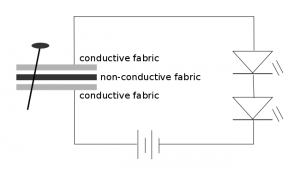
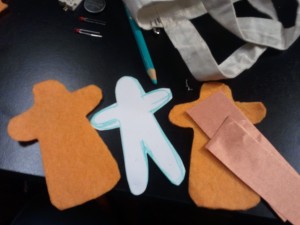
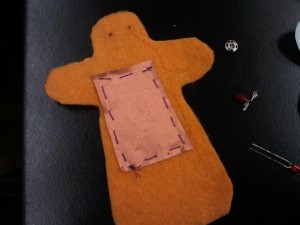
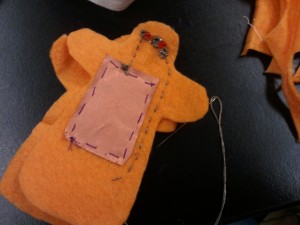
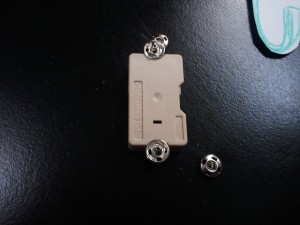
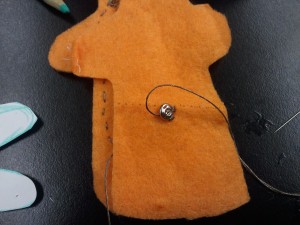
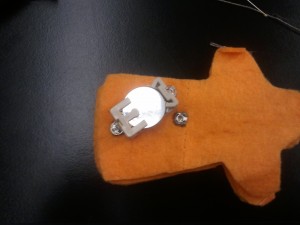
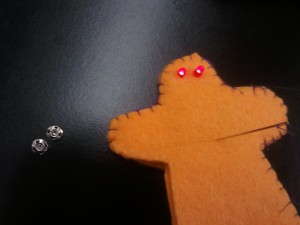
Pingback: Making Soft Sensors « ITP Camp 2011